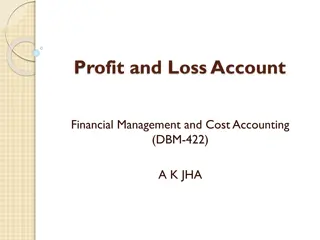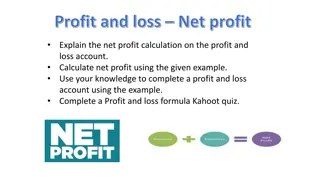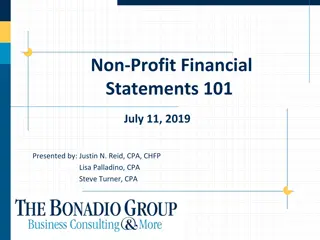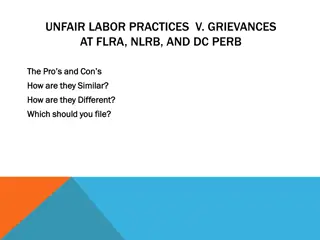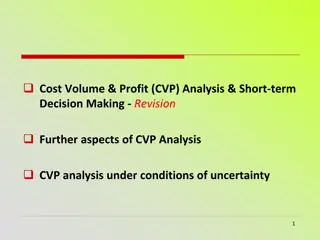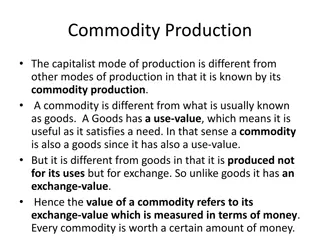Optimizing Labor for Profit in a Competitive Market
Understanding the profit-maximizing quantity of labor in a competitive market for corn production. Analyzing the relationship between marginal revenue product and marginal factor cost to determine the ideal number of farmworkers to hire for maximum profits. A step-by-step mathematical calculation process is illustrated to demonstrate how to make this strategic decision efficiently.
Download Presentation

Please find below an Image/Link to download the presentation.
The content on the website is provided AS IS for your information and personal use only. It may not be sold, licensed, or shared on other websites without obtaining consent from the author.If you encounter any issues during the download, it is possible that the publisher has removed the file from their server.
You are allowed to download the files provided on this website for personal or commercial use, subject to the condition that they are used lawfully. All files are the property of their respective owners.
The content on the website is provided AS IS for your information and personal use only. It may not be sold, licensed, or shared on other websites without obtaining consent from the author.
E N D
Presentation Transcript
How Many Workers Should I Hire? How Many Workers Should I Hire? The profit The profit- -maximizing quantity of labor in a perfectly competitive labor market. maximizing quantity of labor in a perfectly competitive labor market. Instructor s note: These slides contain multiple steps of animation. While in slide show mode, you will need to click multiple times to view all aspects of each slide. Please familiarize yourself with the slides before using in your class.
What Are We Producing? CORN! (Lots and lots of corn! Consumers like corn!)
How Are We Producing CORN? Field 1 Field 2 Seed Drill 1 Seed Drill 2 CORN CORN CORN CORN CORN CORN CORN CORN Team 1 Farmworkers Team 2 Farmworkers LOAN LOAN Work Period = 30 seconds
What Do We Want to Know? EQ: How many farmworkers should we hire to maximize profits? The number of workers up to the point where MRP=MFC! Wage = $5 per farmworker Price = $8 per bushel of corn The additional amount of CORN produced by each per Bushel X Number of Bushels of CORN. farmworkers. Price per Bushel X MPP. Marginal Factor Cost = Wage per Worker X number of additional farmworkers hired each round. Total Revenue Product = Price Total Factor Cost = Wage per Worker X Number of Marginal Revenue Product = The number of times CORN is written in 30 seconds. additional farmworker.
What Do We Need? Ready? Let s go! Team Two Worker Recorder Mathematician Team One Worker Recorder Mathematician
Time for Math! Sample Calculation Price = $8 per bushel of corn Wage = $5 per farmworker $5 $80 $5 $80 10 10 Time for round 2! Each team picks an additional farmworker.
Time for Math! Sample Calculation Price = $8 per bushel of corn Wage = $5 per farmworker $5 $80 $112 $5 $10 $80 $32 10 14 10 4 $5 Time for round 3! Each team picks an additional farmworker.
Time for Math! Sample Calculation Price = $8 per bushel of corn Wage = $5 per farmworker $5 $80 $112 $5 $10 $15 $80 $32 10 14 10 4 $5 $8 1 $120 15 $5 Time for round 4! Each team picks an additional farmworker.
Time for Math! Sample Calculation Price = $8 per bushel of corn Wage = $5 per farmworker $5 $5 $80 $5 $10 $80 $80 $112 $112 $5 $10 $15 $80 $32 $32 10 10 10 14 14 10 4 4 $5 $5 > $8 1 $120 15 $5 < $20 0 $120 $0 $5 15 Do we need to run round 5?
Determining Returns to Scale Round 1 Round 2 Field 1 Field 2 Seed Drill 1 Seed Drill 2 CORN CORN CORN CORN CORN CORN CORN CORN Team 1 Farmworkers Team 2 Farmworkers LOAN LOAN Labor and capital increased by 100% in round 2. Did output increase Work Period = 30 seconds by 100%, more than 100%, or less than 100%?
Returns to Scale Essential Question Two: Are the returns to scale for a firm increasing, decreasing, or constant when doubling the quantity of labor and capital used in production? Wage = $5 per farmworker Rent per seed drill = $10 15 34 It is increasing; output more than doubles when labor and capital are doubled and average total cost falls from $1.00 per bushel to $0.88. ATC = (Wage X # of workers) + (Rent X # of drills) # of units of output


